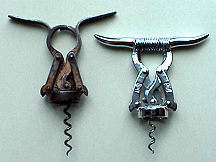
|
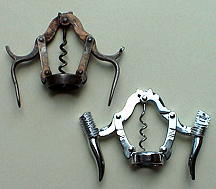
|
Compound Double LeversThe Compound Double Lever Corkscrews on the left is Englishman Heeley's "Empire." This was Heeley's 1890 patent being an improvement on his 1888 patent. It is marked on top of the handles THE "EMPIRE" J. HEELEY & SONS PATENT. The modern corkscrew is the Bull Pull. The packaging states "The Ultimate Corkscrew. The design of this beautifully crafted corkscrew was inspired by the original Empire Double-Lever." |
|
RoundletsOn the left is Nelson Goodyear's 1851 which patent dealt with hard rubber. The middle pair is the1855 patent of Lund and Hipkins marked LUND'S PATENT SPHERICAL JOINT LONDON. The right pair are from Hong Kong. |
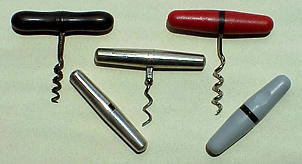
|
Roundlets originated in the eighteenth century with the hinged barrel type containing a double hinged worm. Later versions had cases which either unscrewed or pulled apart with the worm stored in one end. One side is removed, the worm is pulled out and turned perpendicular to the case, then the empty side is threaded or pushed back on to form the handle. A third type is the roundlet which contains several loose tools with one or two slots in their shafts to mate with one or two slots in the case. Lighters, hammers, rasps, spoons, cap lifters and whistles have also been attached in various ways. Roundlets can be found in brass, steel, wood, gold, silver, celluloid, rubber, and plastic. The roundlet specialist can build a rather extensive collection by looking at the great number of variations in design, size and material. |
|
PicnicsA picnic corkscrew has a worm with a short shaft with a ring in the top. The worm is protected by a sheath which is inserted in the ring in the top to form the handle. It is a very convenient stowaway corkscrew for the picnic basket. The pair on the left are 19th Century and the pair in the middle are modern plastic picnics. Gucci sold a slightly different type of picnic. The sheath has a slot to accomodate the leg of the letter G. |

|
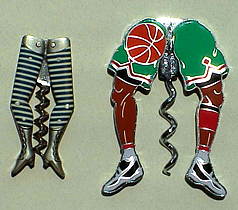
|

|
LegsGay 1890s Legs. and...Gay 1990s Legs - know any basketball players who fill the bill?. |
|
Waiters' FriendsThe corkscrew at top left is marked D.R.PATENT NO. 20815. This is a German patent issued to Karl Wienke in 1882 (An American patent was issued to him in 1883). Wienke is often considered to be the father of the waiter's friend.. Charles Puddefoot worked for the Detroit Corkscrew Company and was issued a patent for his "waiter's friend" which incorporated a cap lifter into the neckstand. At right is a the "Pull-Taps" from Spain which has a double neckstand. The waiter's friend at the bottom is a souvenir of the QE2. This is a very common style modern advertising waiter's friend. |

|
Prong PullersLeft: A two piece prong stored by putting the prong tips into slots in the handles of the opposing pieces. An 1886 French patent by Dugert and Lafittau. Right: The modern "Twist Up." |

|
ThomasonOne of the most important inventions of the nineteenth century was that of Sir Edward Thomason. His design was granted English patent number 2617 on May 7, 1802. He produced his corkscrews in Birmingham and was one of the first major producers of corkscrews. The modern "Thomason" is on the right. |
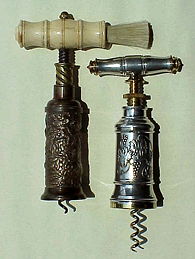
|
Lazy TongsThe father of the lazy tongs corkscrew was Marshall Wier. An abridged version of his 1884 patent specification reads "The screw is attached to a centre pin of the lowest pair of cross-bars of the lazy-tongs, and the ring, which passes over the bottle neck, is hinged to the side bars, suitable stops being provided to prevent lateral motion when the corkscrew is closed. A suitable handle is hinged at the other end of the lazy-tongs" On the left is the modern "Lazy Fish." |
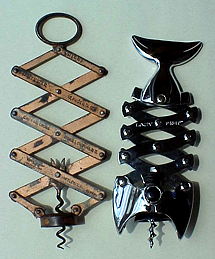
|